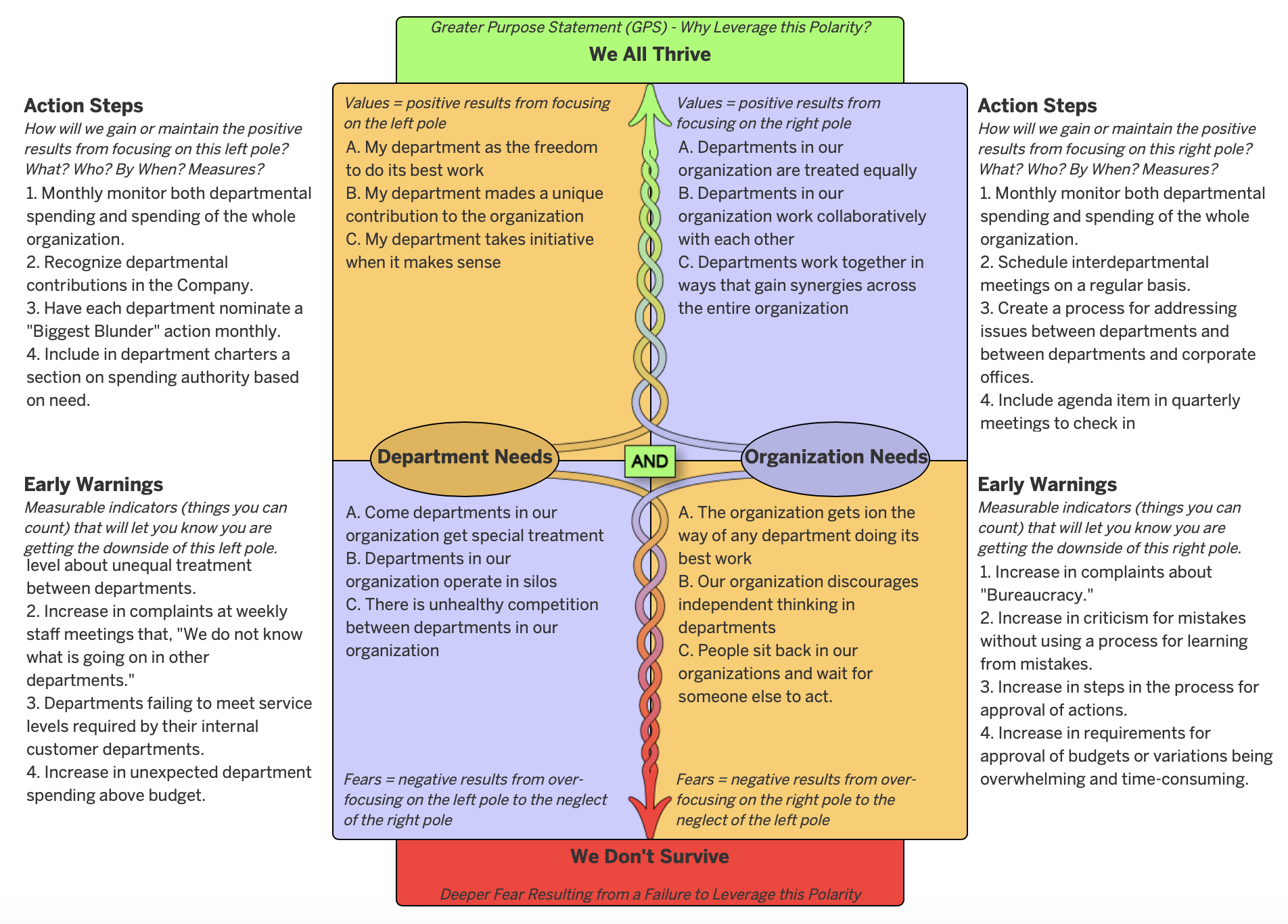In life and at work, there are problems, and there are polarities. Solving problems and leveraging polarities are both critical skills.
A problem (“either/or” thinking) is something that can have a right – or best—answer. A solution exists.
Examples:
-
You either move or not, whether your home or your office.
-
You decide to change jobs or you don’t.
-
You decide to go on vacation or not.
A polarity (“both/and” thinking), also called dilemmas, tensions or paradoxes, are differences between two alternatives that cannot be ignored without serious negative consequence. They are a pair of interdependent alternatives/elements, topics or poles that are ongoing and unsolvable.
When the benefits of both alternatives are experienced at the same time, people and organizations thrive. When one side is focused on to the exclusion of the other, people and organizations underperform.
Elements of a polarity:
-
The tension is experienced over time.
-
They are interdependent alternatives. You can only focus on one for so long before you must focus on the other.
-
Focusing on the upsides of both alternatives over time has positive results.
-
Focusing on one upside to the neglect of the other will eventually undermine productivity and results.
Examples of leadership polarities:
-
Clarity and Flexibility. Clarity without flexibility makes you seem too rigid. Too much flexibility leads to ambiguity.
-
Self-assured and Humble. Leaders seen as overly humble can appear spineless. Leaders who project only self-assuredness may earn a reputation of being arrogant.
-
Directive and participatory. If you are very directive, you can be seen as dictatorial (“my way or the highway”). If you are highly participatory to the exclusion of directive, you can be seen as wishy-washy.
-
Task-focused and relationship-focused. If you are so task-focused that you neglect relationships, you can be seen as heartless and tough. If you are so relationship-focused to the exclusion of task focus, you can be seen as ineffective.
Effective leaders have learned in the examples above that an either/or approach to leadership diminished their effectiveness. They’ve gotten the feedback on their 360s. When they recognized the positives as well as the downsides of each alternative and strived to maximize (leverage) both their relationships, decision making, impact, and productivity dramatically increased.
Organizational polarities:
-
Centralization and decentralization
-
Short-term and long-term
-
Cost and quality
-
Continuity and transformation
-
Team competency and individual competency
-
Mission and margin
Leaders, teams and organizations that leverage polarities—that combine the benefits of both parts of the whole--will outperform those that don’t.
What Polarities Do Individuals Commonly Face?
-
Work and life
-
Intuition and facts
-
Optimism and reality
-
Caution and courage
-
Self and other
-
Structure and flexibility
Polarity Thinking as Part of the Coaching Process
Being certified in polarity thinking, I help my clients:
- Identify, see, and name the polarities that are most important and strategic to them as leaders and for their organization’s success
- See and discuss the dilemma as a whole from multiple perspectives
- Identify and map the upsides and downsides of each alternative
- Identify the major benefit for managing the polarity well and the major negative for not managing it well
- Assess how they are currently managing polarities
- Identify action steps to maximize benefits
- Leverage the polarities – build action steps and strategies to maximize upsides; pay attention to early warning signs that let you know when you are in the downside; self-correct quickly
- Recognize polarities as energy systems and use that energy to maximize benefits
Learning and leveraging polarities:
-
Avoids the downward cycle of pendulum swings between alternatives—even when cycles occur over long time periods
-
Improves active stakeholder participation from people who lean toward one or the other of the two alternatives; allows all participants to gain a great understanding of where everyone is coming from
-
Helps each person understand the upsides and downsides of their point of view and those of the opposite viewpoint
Example of polarity outcomes
Before and After Polarity Thinking – Departmental Needs and Organizational Needs
Before polarity thinking – A sales executive is swamped with work, and performance reviews are due. Coming from a departmental lens, the sales executive wants to keep up all the sales activities, HR, the corporate office and performance reviews be dammed. From the organizational view, however, HR is frustrated because the sales executive is shirking organization-wide responsibilities. The emails from HR are unanswered. No reviews are done. Employees are unhappy, and some high performing sales staff are thinking about leaving the company.
After polarity thinking – The sales and HR executives met to discuss the upsides and downsides of departmental focus and organizational focus. It was eye-opening for them to learn each other’s perspectives. Until this work on polarity and the outcomes it achieved, neither had been aware of the amount of time, negative energy, and diminished productivity their either/or thinking took.
The HR director worked with the sales executive to develop and deliver the performance reviews. Employees appreciated the comprehensive and timely feedback. The sales executive was even more effective because he was not distracted by what he wasn’t doing. This solution came out of the creation of a polarity map by the sales and HR departments. They mapped out the benefits of both departmental and organizational needs, the downsides of each, action steps to leverage both the departmental and organizational needs, and early warning signs that things were in decline. Sales management got an enhanced perspective of the benefits to the organization, and HR management got an enhanced perspective of the sales department's view. Together, they recognized their common need for a robust and thriving organization.

Before and After Polarity Thinking – Activity and Rest
Before polarity thinking – A high-potential, high-performing employee was driven by perfection, didn’t know how to say “no,” and was exhausted. The overload caused great stress and even guilt because the employee wasn’t doing any self-care. The employee was short with colleagues, and her normally high performance was falling. The employee was in constant activity without the benefit of rest and renewal. Her mindset was either/or. Either I work or I don’t. I can’t do both.
After polarity thinking – After thinking about what it takes to be a fully effective/healthy person, the employee identified the upsides of activity (work) and, most importantly, the upsides of rest. The employee gained insights into leveraging both activity (work) and rest. As the employee incorporated rest (taking pauses, walking, sleeping, deep breathing, seeing friends) into her life, she found her productivity and creativity increased, and her work relationships with colleagues improved.
Before and After Polarity Thinking – Tradition and Innovation
Before polarity thinking – There was great division, misunderstanding and frustration between the finance and product development departments. Product Development saw the checks and balances of finance as slowing down and interfering with the innovation needed to move the company forward. Finance saw innovation as running rampant, putting the company at a high risk. Meetings between the two departments were at best cool and more often heated and nonproductive.
After polarity thinking – As the two groups worked together to understand the benefits of both tradition and innovation, they were able to create both the action steps to keep the company healthy. In addition to identifying the upsides and downsides of each focus, they also identified the early warning signs that they might be on a downward trajectory. Inter-department meetings became more productive, there was increased respect across departments, risk was reduced and innovation continued.



